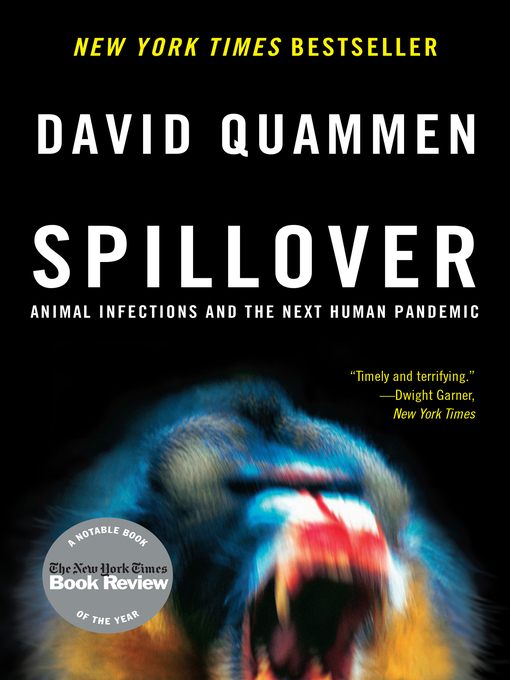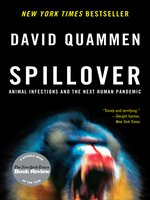-

August 6, 2012
Quammen (The Song of the Dodo) is a masterful writer who adroitly blends science and journalism, speculation and fact, as well as horror and humor in his latest tour de force. He traverses the globe exploring cases in which animal-borne diseases somehow jump to humans, often with devastating consequences. This cross-species transmission of diseaseâthe âspilloverâ of the bookâs titleâhas happened for the 200,000 years modern humans have been present on the earth, but the frequency and consequences of such events have been increasing dramatically in recent years. According to Quammen, diseases of this sort are responsible for âthe death of more than 29 million people since 1981.â And, as he explains so well, these diseases ârepresent the unintended results of things we are doing.â Environmental destruction, burgeoning human populations, increased mobility, and extremely different patterns of food production are all part of his story. Quammen is adept at describing the epidemiology, anthropology, and molecular biology of SARS, AIDS, Ebola, and a host of other frightening maladies. His profiles of researchers, both in the lab and in the field, are every bit as compelling as are his descriptions of those unlucky enough to catch one of these dreadful diseases. This is a frightening but critically important book for anyone interested in learning about the prospects of the worldâs next major pandemic.
-

October 1, 2012
Zoonoses, most simply described as diseases transmitted from animals to humans, include exotic horrors like Ebola and far more common ailments such as influenza, HIV, and Lyme disease. Vividly describing the work of field biologists and laboratory scientists, Quammen (The Reluctant Mr. Darwin: An Intimate Portrait of Charles Darwin and the Making of His Theory of Evolution) takes readers on a series of journeys, including tracking gorillas in the jungles of Gabon and catching bats on the roof of a Bangladeshi warehouse. The researchers he interviews note that as human populations continue to grow, they will inevitably move into habitats with unfamiliar, dangerous microorganisms, and as international travel becomes more popular and more efficient, those microorganisms can be transmitted faster and farther than ever before. VERDICT For a shorter, more humorous consideration of some of the same issues (and diseases), consider The Chickens Fight Back: Pandemic Panics and Deadly Diseases That Jump from Animals to Humans by David Waltner-Toews. Quammen's is a compelling and quietly alarming book; recommended for readers interested in biology, medicine, or veterinary science. [See Prepub Alert, 4/16/12.]--Nancy R. Curtis, Univ. of Maine Lib., Orono
Copyright 2012 Library Journal, LLC Used with permission.
-

Starred review from May 1, 2012
Nature writer and intrepid traveler Quammen (The Reluctant Mr. Darwin, 2006, etc.) sums up in one absorbing volume what we know about some of the world's scariest scourges: Ebola, AIDS, pandemic influenza--and what we can do to thwart the "NBO," the Next Big One. The author discusses zoonoses, infectious diseases that originate in animals and spread to humans. The technical term is "spillover." It's likely that all infections began as spillovers. Some, like Ebola and lesser-known viral diseases (Nipah, Hendra, Marburg), are highly transmissible and virulent, but so far have been limited to sporadic outbreaks. They persist because they are endemic in a reservoir population through a process of mutual adaptation. Finding that reservoir holds the key to control and prevention and gives Quammen's accounts the thrill of the chase and the derring-do of field research in rain forests and jungles and even teeming Asian cities where monkeys run wild. The author chronicles his travels around the world, including a stop in a bat cave in Uganda with scientists who found evidence that bats were the source of Marburg and other zoonoses, but not AIDS. Quammen's AIDS narrative traces the origin of HIV to chimpanzee-human transmission around 1908, probably through blood-borne transmission involved in the killing of the animal for food. Over the decades, with changing sexual mores, an ever-increasing world population and global travel, the stage was set for a takeoff. Quammen concludes with a timely discussion of bird flu, which has yet to achieve human-to-human transmission but, thanks to the rapid mutation rate and gene exchanges typical of RNA viruses, could be the NBO. You can't predict, say the experts; what you can do is be alert, establish worldwide field stations to monitor and test and take precautions. A wonderful, eye-opening account of humans versus disease that deserves to share the shelf with such classics as Microbe Hunters and Rats, Lice and History.
COPYRIGHT(2012) Kirkus Reviews, ALL RIGHTS RESERVED.
-

Starred review from October 1, 2012
Exemplary science writer Quammen schools us in the fascinating if alarming facts about zoonotic diseases, animal infections that sicken humans, such as rabies, Ebola, influenza, and West Nile. Zoonoses can escalate rapidly into global pandemics when human-to-human transmission occurs, and Quammen wants us to understand disease dynamics and exactly what's at stake. Drawing on the truly dramatic history of virology, he profiles brave and stubborn viral sleuths and recounts his own hair-raising field adventures, including helping capture large fruit bats in Bangladesh. Along the way, Quammen explains how devilishly difficult it is to trace the origins of a zoonosis and explicates the hidden process by which pathogens spill over from their respective reservoir hosts (water fowl, mosquitoes, pigs, bats, monkeys) and infect humans. We contract Lyme disease after it's spread by black-legged ticks and white-footed mice, not white-tailed deer as commonly believed. The SARS epidemic involves China's wild flavor trend and the eating of civets. Quammen's revelatory, far-reaching investigation into AIDS begins in 1908 with a bloody encounter between a hunter and a chimpanzee in Cameroon. Zoonotic diseases are now on the rise due to our increasing population, deforestation, fragmented ecosystems, and factory farming. Quammen spent six years on this vital, in-depth tour de force in the hope that knowledge will engender preparedness. An essential work.(Reprinted with permission of Booklist, copyright 2012, American Library Association.)
-
Dwight Garner;The New York Times
That [Quammen] hasn't won a nonfiction National Book Award or Pulitzer Prize is an embarrassment. . . . Timely and terrifying. Mr. Quammen, a gifted science writer, combines physical and intellectual adventure. He also adds a powerful measure of moral witness: ecological destruction is greatly to blame for our current peril.
-
Nathan Wolfe;Nature
David Quammen [is] one of that rare breed of science journalists who blend exploration with a talent for synthesis and storytelling.
-
Georges Simenon;Wired
Riveting, terrifying, and inspiring.
-
Kathryn Schulz;New York Magazine
David Quammen might be my favorite living science writer: amiable, erudite, understated, incredibly funny, profoundly humane. The best of his books, The Song of the Dodo, renders the relatively arcane field of island biogeography as gripping as a thriller. That bodes well for his new book, whose subject really is thriller-worthy: how deadly diseases (AIDS, SARS, Ebola) make the leap from animals to humans, and how, where, and when the next pandemic might emerge.
-
Cleveland Plain Dealer
[Spillover is] David Quammen's absorbing, lively and, yes, occasionally gory trek through the animal origins of emerging human diseases.
-
Seattle Times
As page turning as Richard Preston's The Hot Zone... [Quammen is] one of the best science writers.
-
Philadelphia Tribune
[Spillover] delivers news from the front lines of public health. It makes clear that animal diseases are inseparable from us because we are inseparable from the natural world.
-
Publishers Weekly
Starred review. ...a frightening but critically important book for anyone interested in learning about the prospects of the world's next major pandemic.
-
Kirkus Reviews
Starred review. A wonderful, eye-opening account of humans versus disease.








